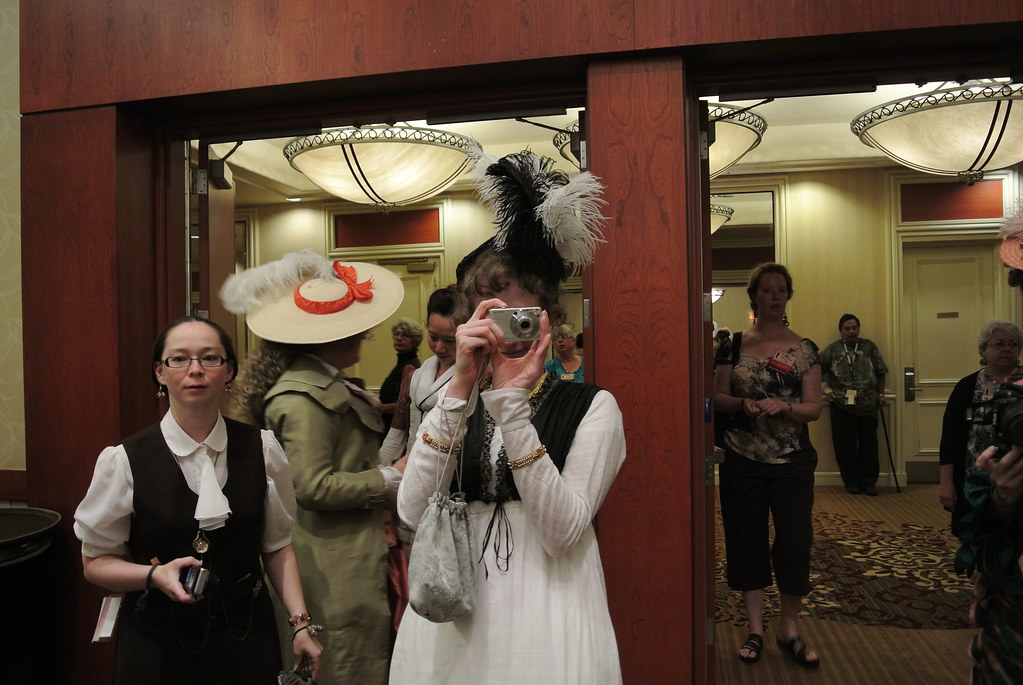
I can't help feeling a little bit like I punted for this challenge. My UFO was already so close to being finished, so it took just a little bit of time. But that's part of my "master plan" for getting bunches of stuff done before June.
It started last summer, when I decided to make a 1780s gown out of pink wool. One of the things that stood out to me about 1780s styles was the big, fluffy, often frilled handkerchiefs worn over the gowns, covering the very low necklines. I didn't actually finish the gown until the Wednesday before Costume College, however, so my plans for a foofy handkerchief weren't complete. Instead, I wore the cut, but completely un-ruffled and un-hemmed, handkerchief.

The fabric is marvelous stuff, a "barred" cotton organdy I got from the Pure Silks ebay store some years ago. Even after washing it, it remains crisp, as if starched. I used it for my first (and current only) 18th century cap.

The shape is a regular right triangle approximately 18" a side, with a 3" slit cut in the hypotenuse for it to fold around the neck more gracefully, as in this example.
The next chapter in the Handkerchief Saga opens with my push to finish lots of things for the Georgian Picnic in November. It had bottom priority because it was wearable (unlike the bum pad or petticoats), and I really wanted to trim the dress. I ended up with barely enough time to attach the ruffle. My specific inspiration for the ruffle was this handkerchief ("fichu") from the Metropolitan Museum of Art:
I started by working the ruffle itself, because I knew that would take the longest. I think I cut it twice as long as the two sides of the handkerchief, and 1.25" wide finished. I love the organdy so much! Although loosely woven, it's crisp enough to make rolled hemming very easy. I made extra-small hems on the ruffles, mostly just to see if I could. The big squares in the organdy are about 1/4", so the hem is a little more than 1/16".

The edges of the handkerchief also had to be hemmed first. Then the ruffle was drawn up with whipped gathers and sewn to the finished edge.

I still barely finished before the picnic. The evening before, I sang in a concert at my church. And I was backstage stitching for dear life the whole time I wasn't performing! I even had expert help from friend and fellow singer Kathy, who finished hemming the outside edges of the handkerchief while I was sewing the gathers.
 |
| Working separately: Handkerchief on left, ruffle on right. |
 |
| Working together: Attaching the ruffle, and nearly done hemming the handkerchief. |
The raw inside edges of the handkerchief were completely hidden when I wore it. I was surprised by how differently it lay with the ruffle on it, but I liked the look.


But still, those raw edges bothered me. Instead of putting it away, the handkerchief has been haunting my cutting table for the months since the picnic. So the UFO challenge was perfect for getting it done.

Just the Facts, Ma'am:
The Challenge: HSF #2, UFO
Fabric: White cotton woven 1/4" windowpane organdy
Pattern: Roughly from the pin above, from 18th Century Embroidery Techniques
Year: 1780s into 1790s
Notions: None
How historically accurate is it? It would be more commonly made of linen instead of cotton. Other than that, and the content of the thread (lightweight Coats & Clark), it's as accurate as I know how.
Hours to complete: To complete the UFO, 2 hours at most. Before then, maybe 8.
First worn: Unfinished 1: August 2012, Costume College. Unfinished 2: November 2012, DFWCG Georgian Picnic. Completed: Not yet!
Total cost: Pennies for the little bit of thread. Maybe $2 for the fabric, originally.
































